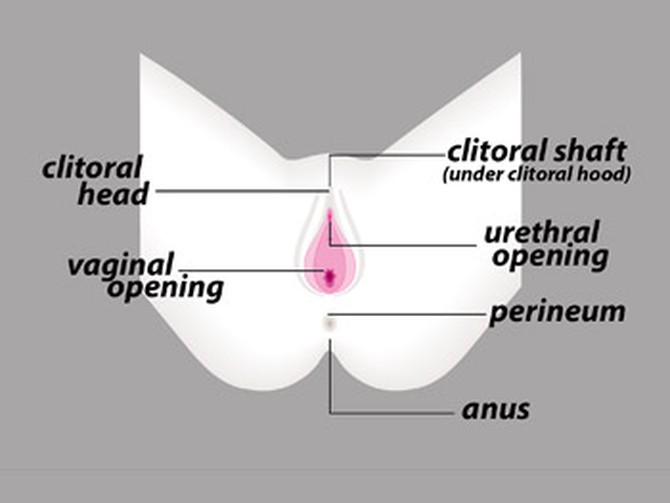Female Anatomy 101

More than 50 percent of American adults say they are unsatisfied with their sex lives. Dr. Laura Berman, a sex therapist and the founder of the Berman Institute for Sexual Health, says knowing your own body is a huge contributor to sexual satisfaction. "If you want [your partner] to be inside your vagina, you've got to be comfortable with your vagina too," she says.
The first step toward being comfortable with the female anatomy is using the correct terminology, Dr. Berman says. "Va-jay-jay's very cute. However, I encourage people to use the real terms," she says. "A lot of people use 'va-jay-jay' because they're too uncomfortable to actually say 'vulva' or 'clitoris' or 'vagina.'" Dr. Berman also says you should teach your children the correct anatomical names. "That's the earliest sex education for them," she says.
The first step toward being comfortable with the female anatomy is using the correct terminology, Dr. Berman says. "Va-jay-jay's very cute. However, I encourage people to use the real terms," she says. "A lot of people use 'va-jay-jay' because they're too uncomfortable to actually say 'vulva' or 'clitoris' or 'vagina.'" Dr. Berman also says you should teach your children the correct anatomical names. "That's the earliest sex education for them," she says.

When it comes to knowing your body, Dr. Berman says women should learn what everything is, where it is located and what it does. A woman's vulva is the entire external region, and a vagina is just the internal part, Dr. Berman explains. "When you're calling [the vulva] a vagina, you're reducing a woman's whole genitals to that internal canal," she says.
Watch Dr. Berman's anatomy lesson!
Women have three openings: the urethra, the vagina and the anus. Dr. Berman says women often believe that urine comes out of the vagina, but in fact it come out of the urethral opening.
Stimulation of the clitoris is the most common source of female orgasms, Dr. Berman says. "The clitoris is actually 10 to 12 centimeters in length. It branches out internally and reaches almost to the pubic bone in a woman's body," she says. "But this area has more nerve endings than any other part of the body and more nerve endings than a man's entire penis. It's a very important hot spot in a woman's anatomy."
Watch Dr. Berman's anatomy lesson!
Women have three openings: the urethra, the vagina and the anus. Dr. Berman says women often believe that urine comes out of the vagina, but in fact it come out of the urethral opening.
Stimulation of the clitoris is the most common source of female orgasms, Dr. Berman says. "The clitoris is actually 10 to 12 centimeters in length. It branches out internally and reaches almost to the pubic bone in a woman's body," she says. "But this area has more nerve endings than any other part of the body and more nerve endings than a man's entire penis. It's a very important hot spot in a woman's anatomy."
Keep Reading

If a woman wants to have a vaginal orgasm, Dr. Berman says she needs to find her G-spot. "If a woman's lying on her back, inserts two fingers into the vagina on the belly button side [about two-thirds of the way in] and kind of moves her fingers ... she'll feel the G-spot," she says. The tissue of the G-spot feels different than the rest of the vagina. "Some women say it feels almost like the tip of their nose."
While you're doing this experiment, don't be surprised if you feel like you have to go the bathroom. "When you're stimulating the G-spot, you'll have the sensation that you have to urinate because of the G-spot's proximity to the urethra. ... That's a sign you're in the right place."
Dr. Berman says you have to identify your own G-spot before anyone else can. "You've got to find it yourself first," she says. "Or else he may never be able to find it."
While you're doing this experiment, don't be surprised if you feel like you have to go the bathroom. "When you're stimulating the G-spot, you'll have the sensation that you have to urinate because of the G-spot's proximity to the urethra. ... That's a sign you're in the right place."
Dr. Berman says you have to identify your own G-spot before anyone else can. "You've got to find it yourself first," she says. "Or else he may never be able to find it."

The muscles in a woman's pelvic floor region contract and release when she is having sex. According to Dr. Berman, the strength of these muscles contributes to the strength of the orgasm that a woman can have. "They also provide more friction against the G-spot if you use them during sex," Dr. Berman says.
As a woman ages or if she has a baby, the pelvic floor muscles can become loose. "Those are the muscles that you squeeze to stop the flow of urine. That's how you identify them—those are the Kegels," Dr. Berman says. "You have to strengthen them using those core muscle exercises and Kegel [exercises]. And if you have really strong Kegel muscle control, you should be able to squeeze your vagina ... in and up [and] in and back, and if you're really in control, side to side."
Get more advice from Dr. Berman on how to add the spark back to your sex life!
As a woman ages or if she has a baby, the pelvic floor muscles can become loose. "Those are the muscles that you squeeze to stop the flow of urine. That's how you identify them—those are the Kegels," Dr. Berman says. "You have to strengthen them using those core muscle exercises and Kegel [exercises]. And if you have really strong Kegel muscle control, you should be able to squeeze your vagina ... in and up [and] in and back, and if you're really in control, side to side."
Get more advice from Dr. Berman on how to add the spark back to your sex life!
Published 11/03/2008




